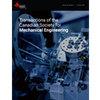Band gap generation in cantilever beams through periodic material removal
IF 0.8
4区 工程技术
Q4 ENGINEERING, MECHANICAL
Transactions of The Canadian Society for Mechanical Engineering
Pub Date : 2024-07-04
DOI:10.1139/tcsme-2024-0013
引用次数: 0
Abstract
Traditional methods for generating band gaps in beams usually involve adding periodic elements like tuned mass dampers or masses, or applying complex geometrical changes. This research suggests a subtraction-based method achieved by removing material in the thickness direction through straightforward machining operations, thus forming periodic cells. The numerical studies start with band gap analysis, using periodic theory to assess different periodic cell configurations. This is followed by numerical and experimental studies on cantilever beams, each containing a set number of these periodic cells. Non-contact vibration measurements are conducted on one plain and six machined aluminum beams using a multipoint laser vibrometer and an automated impact hammer. The experimental findings corroborate the band gaps predicted by the numerical model, confirming the effectiveness of this approach. The study notes that the optimal periodicity of the cells and the contrast in thickness vary with the beam’s dimensions, and that the thickness contrast markedly affects the quantity, width, and intensity of the resulting band gaps. These results indicate that (1) periodic material removal in beam-like structures allows improved vibration reduction while mass is reduced, and (2) manufacturing can play a key role in vibration control in simple structures.通过周期性材料去除在悬臂梁中产生带隙
在梁中产生带隙的传统方法通常涉及添加周期性元素,如调谐质量阻尼器或质量块,或应用复杂的几何变化。这项研究提出了一种基于减法的方法,通过直接加工操作去除厚度方向的材料,从而形成周期性单元。数值研究从带隙分析开始,利用周期理论评估不同的周期单元配置。随后是悬臂梁的数值和实验研究,每个悬臂梁都包含一定数量的周期单元。使用多点激光测振仪和自动冲击锤对一根普通铝梁和六根机加工铝梁进行了非接触式振动测量。实验结果证实了数值模型预测的带隙,证实了这种方法的有效性。研究指出,单元的最佳周期和厚度对比随梁的尺寸而变化,厚度对比明显影响所产生的带隙的数量、宽度和强度。这些结果表明:(1) 在类似梁的结构中进行周期性材料去除,可以在减少质量的同时改善减振效果;(2) 制造工艺可以在简单结构的振动控制中发挥关键作用。
本文章由计算机程序翻译,如有差异,请以英文原文为准。
求助全文
约1分钟内获得全文
求助全文
来源期刊
CiteScore
2.30
自引率
0.00%
发文量
53
审稿时长
5 months
期刊介绍:
Published since 1972, Transactions of the Canadian Society for Mechanical Engineering is a quarterly journal that publishes comprehensive research articles and notes in the broad field of mechanical engineering. New advances in energy systems, biomechanics, engineering analysis and design, environmental engineering, materials technology, advanced manufacturing, mechatronics, MEMS, nanotechnology, thermo-fluids engineering, and transportation systems are featured.

 求助内容:
求助内容: 应助结果提醒方式:
应助结果提醒方式:


